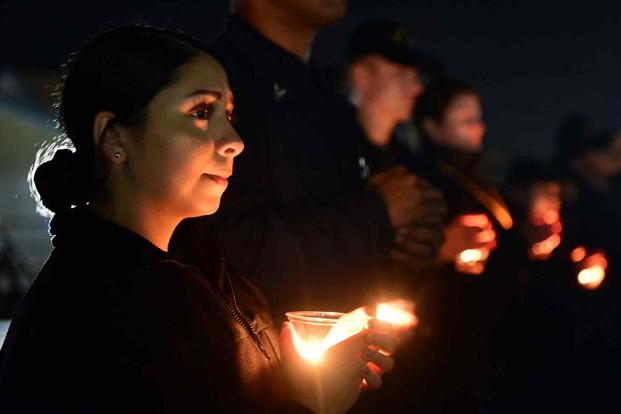Nearly 30% of the commanding officers in the Navy’s largest units could not produce suicide crisis response plans when requested, a finding that, if addressed, Pentagon investigators say could save lives and also prevent unwarranted restrictions on sailors’ access to firearms.
Followin a rash of suicides aboard Navy ships during maintenance periods in shipyards and at the request of Congress, the Defense Department inspector general conducted a review of the service’s suicide prevention and response programs, delving into the availability of mental health treatment for sailors with suicidal ideation and how the Navy handles suicide attempts and suicides.
The report, released Thursday, found that the service does not track whether its commanders have suicide crisis plans as required. When auditors surveyed 277 commanders from U.S. Fleet Forces Command and U.S. Pacific Fleet, 79 either did not have a local crisis response plan, told investigators they had one but didn’t provide it, or simply didn’t respond.
Read Next: Army Seeing Major Recruiting Momentum in 2025 After Hitting Goal Last Year
Of the plans that were submitted, nearly half did not include a reporting requirement to the Sailor Assistance and Intercept for Life, or SAIL, program, which provides immediate response, care coordination and support for active-duty sailors in crisis. Roughly 215 did not contain a list of mental health resources with accurate contact information, and 6% were not specifically tailored to the commands.
“Without each Navy command having a tailored crisis response plan, the Navy risks inadequate identification and response to a sailor in crisis, improperly restricting access to lethal methods of suicide, and insufficient oversight of a sailor in crisis,” the investigators wrote.
At least nine suicides occurred in 2022 among the crew of the carrier George Washington while it was undergoing a yearslong overhaul in Virginia’s Newport News Shipyard. Also in 2022, four suicides occurred among sailors at the Mid-Atlantic Regional Maintenance Center in Norfolk, Virginia.
In 2023, three sailors died by suicide while assigned to the carrier Theodore Roosevelt while it was in the yard at Bremerton, Washington.
In subsequent investigations, the Navy found that quality-of-life issues and general failures in caring for sailors contributed to widespread despondency among the ships’ crews. At the maintenance center, a review found that the command was not equipped to handle the mental health treatment needs of the service members.
To address the issues, the Navy has ramped up programs to help sailors and increased spending on suicide prevention, tripling the $43 million budget in 2023 to $122 million in 2025.
The audit found that the Navy largely maintained accurate data on suicides and had the resources needed to respond to sailors in crisis. Some units sometimes struggled to assist sailors in need, especially when at sea, when communication with land-based providers is difficult.
A Navy official who was not named in the report also told investigators that the service’s suicide prevention training lacks effectiveness because it is not designed to change behavior and is the same every year. The report noted that new suicide prevention training was scheduled to be introduced in February 2025.
The DoD Office of Inspector General recommended that the Navy Culture and Force Resilience Office develop and implement a plan to ensure that all Navy commands maintain a complete local crisis response plan.
It also believes that the Navy should have a dedicated office that tracks commands’ crisis response plans and ensures that they contain accurate information, including mental health resources and contact information.
The Navy concurred with the first recommendation but took issue with the second, saying that creating a central oversight office would burden commanders and minimize their authority and responsibility.
“The responsibility of a commanding officer for his or her command is absolute,” wrote Rear Adm. Jay Clark, director of the Culture and Force Resilience Office, also known as N17.
Clark agreed that commanding officers should ensure that their subordinate commands have crisis response plans in place as required.
An analysis released Wednesday by the Rand Epstein Family Veterans Policy Research Institute, a think tank that conducts research on military and veteran populations, found that the most effective programs for preventing suicide among military personnel and veterans were local, community-based programs; assessments for suicide risk; noncrisis psychological treatment; clinical crisis response; and medication for those with mental health conditions.
For its report, Preventing Veteran Suicides, Rand researchers reviewed 307 current and proposed suicide prevention programs and developed a framework for organizing the efforts to improve effectiveness. They said that, while the “volume and diversity” of the programs “reflect a nation committed to a common goal” of suicide prevention, they also can create confusion over what works, are duplicative or don’t reach the target audience.
“By categorizing the different types of suicide prevention activities and organizing them
within a matrix, we have developed a framework to consider what a comprehensive approach
to suicide might look like,” wrote the researchers, led by institute codirector and senior behavioural scientist Rajeev Ramchand.
In 2022, 71 active-duty and seven reserve sailors took their lives, while in 2023, 68 active-duty and eight reserve members died by suicide. In 2024, there were 61 active-duty sailors and 10 reserve members who died, according to Pentagon data.
Related: ‘Stick Around, We Need You’: The Navy’s Top Officer Opens Up About His Worry Over Suicide
Story Continues
Read the full article here


